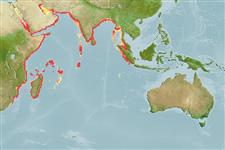Common names from other countries
Environment: milieu / climate zone / depth range / distribution range
Ecología
; salobre; rango de profundidad 1 - 170 m (Ref. 8), usually 10 - 30 m (Ref. 8). Tropical, preferred 26°C (Ref. 107945); 30°N - 31°S, 29°E - 103°E
Indo-West Pacific and Southern Atlantic. Introduced in the Mediterranean. Tropical to subtropical.
Length at first maturity / Tamaño / Peso / Age
Maturity: Lm 12.7, range 11 - 12 cm Max length : 19.9 cm TL macho / no sexado; (Ref. 119750); 22.6 cm TL (female); edad máxima reportada: 2.50 años (Ref. 104940)
Maximum carapace length: 5.0 cm (female; Ref. 8). Prefers bottom sandy mud (Ref. 8). Also occurs on seagrasses, mudflats, sandflats and mangrove channels. Frequently burrows (Ref. 106912). Feeds on crustaceans, polychaetes, mollusks, fishes, algae and detritus (Ref. 104916).
Mating behavior: Precopulatory courtship ritual is common (through olfactory and tactile cues); usually indirect sperm transfer (Ref. 833). Females spawn once every two (2) months (Ref. 104933).
Holthuis, L.B. 1980. (Ref. 8)
IUCN Red List Status (Ref. 130435)
CITES status (Ref. 108899)
Not Evaluated
Not Evaluated
Human uses
Pesquerías: comercial; carnada: occasionally
FAO - pesquerías: landings | FishSource | Sea Around Us
Herramientas
Fuentes de Internet
Estimates based on models
Preferred temperature
(Ref.
115969): 25.2 - 29.3, mean 27.8 (based on 258 cells).
Resiliencia
Alto, población duplicada en un tiempo mínimo inferior a 15 meses (K=0.67-2.2; tmax=2.5).
Prior r = 1.11, 95% CL = 0.74 - 1.67, Based on 2 data-limited stock assessments.
Vulnerability
Low vulnerability (10 of 100).
